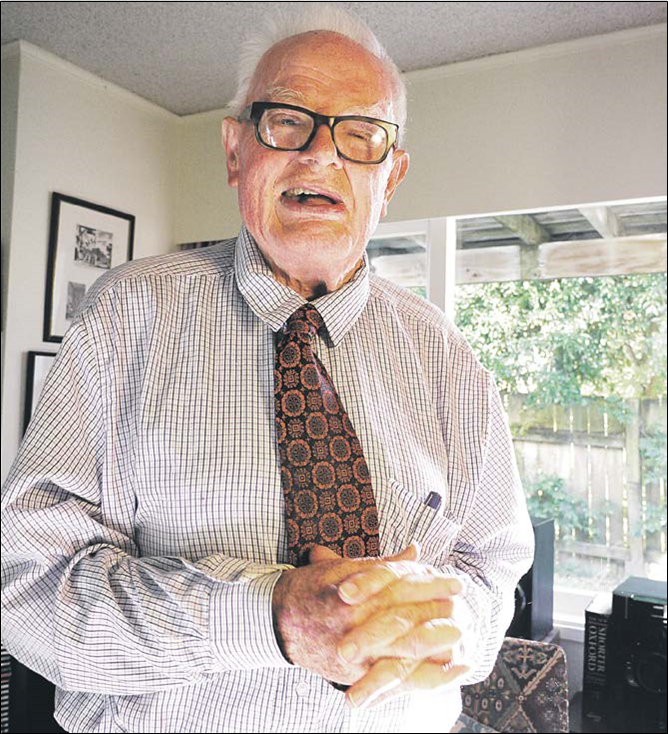Computer pioneer was a familiar figure on the ferry
Obituary
Source: The Devonport Flagstaff. March 8, 2024. Re-published here with permission.
Retired mathematics professor Garry Tee, a pioneer in computer science in New Zealand and a noted science historian, has died, aged 91.
For more than 50 years Tee was a regular on the Devonport ferry on the way to Auckland University – known for his distinctive plaid cap and in later years gait, aided by a walking stick and then a walking frame.
He worked out exactly how long it took him to walk to the ferry from his Domain St home – 11 minutes, extended to 13, due to feline interruptions on route.

"Any one of those cats was likely to come out and order me to stroke it before proceeding further," he told the Flagstaff in a 2018 interview.
Tee grew up during the 1930s Great Depression and in the South Island railway camps of that era. His father was an engineer, and Garry showed a precocious mathematical talent, even as an eight-year-old. He leapfrogged primary classes two years at a time. Then, aged 11, and with the elite Auckland schools open to him, chose Seddon Memorial Technical College. He skipped School Certificate and University Entrance, and went straight to the New Zealand University Junior Scholarship exams.
The results came out in 1948 when the Tee family was holidaying near Russell. Tee picked up a New Zealand Herald at the local shop. A front-page story quoted an ecstatic Seddon Tech headmaster whose pupil was best in the Junior Scholarship results.
In 1954 he completed a first-class honours MSc degree in mathematics at Auckland University, then left for north-west Australia. There he crouched in a Quonset hut using mechanical calculators and slide rules as practical aids to turn raw oil exploration data into useable summaries and graphs.
Tee worked as a mathematician at the English Electric Company in 1958, developing the DEUCE computer based on Alan Turing's design for the ACE computer initially formulated at Bletchley Park in the UK. He became a foundation member of the Department of Mathematics at the University of Lancaster in 1964 and a visitor at the Computer Science department of Stanford University in 1965.
He returned to New Zealand as a senior lecturer in mathematics at the University of Auckland in 1968, where he remained until his retirement. He was a founding member of the university's Computer Science department. He was considered to be one of the pioneers of computer science in New Zealand, and a leading historian of maths, science and computers.
He produced carefully researched papers that delved into this country's links to 19th century and 20th century science.
He'd noted that rich tradition even as early as 1971, when the Museum of New Zealand's geology exhibition displayed a historic iguanodon tooth. The tooth was the world's first proof of an ancient land-based reptile – a dinosaur. The tooth had been brought to New Zealand by collector Walter Mantell's son, who'd gifted it to the museum.
Seven years later, Tee checked the museum again, and the tooth had disappeared, into the dim, overstuffed museum basement, where objects are forgotten due to staff changes, and later go out with the rubbish. Tee stayed on the case, insisting "this highly significant fossil" be found. Weeks later, as a result of his agitation, it was located. These days it's one of Te Papa Tongarewa's most treasured items.
Another astonishing relic came to public notice when Tee identified a rusty piece of machinery that had gathered dust for a century on a farm near Whanganui. It was part of a large 'difference engine' that was being built in the 1820s by the engineering genius Charles Babbage. It was another significant piece of science history, for Babbage is acknowledged as the father of modern computing. Despite Tee's attempts to preserve it within New Zealand, the relic was later sold for $1million.
In 1981, Tee faced his greatest crisis, a brain tumour. He had little option but surgery, and the outcome was uncertain.
"The operation took 12 hours. I awoke as the nexus of a maze of wires and tubes. After three days, I felt strong enough to look at a book. A cousin visited me, and I invited him to take out the largest of the three volumes I'd brought to the hospital – a large treatise on advanced mathematics, in Russian. He later told me he'd never seen such a look of relief as flooded over my face, when I found I could read the Russian text, and understand the mathematics, without effort," Tee told the Flagstaff.
The monographs kept coming – on the electromagnetics of Michael Faraday, and the extensive correspondence between the botanist and biologist Charles Darwin and New Zealand scientists. He also encouraged others – most prominently Catherine Caughey – sworn to secrecy for her work with the Colossus computer at Bletchley Park during World War II – who published her story in 1996.
In his spare time Tee was a keen diver and underwater photographer. Tee died at a Herne Bay care home on 18 February.